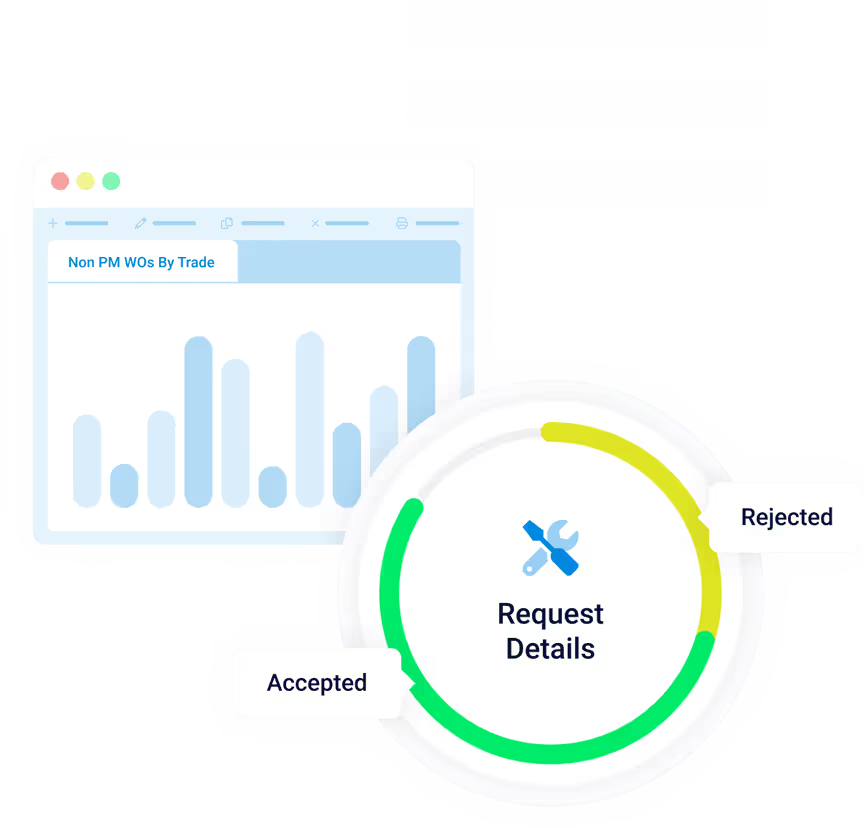How are you managing your maintenance?
Often facility teams find themselves manually managing work requests and tracking maintenance tasks. This can lead to duplicated work, unreliable data and a misallocation of resources. Using an enterprise asset management (EAM) solution eliminates inaccuracies and labor spent manually managing projects.
Leveraging maintenance software means that you and your team have the ability to optimize use, availability, and life span of equipment, machinery, fleets, infrastructures, facilities, and operations. With a centralized digital database, you can easily track and report on maintenance projects, saving time and money.
An EAM helps facility leaders track and streamline:
- Asset Lifecycle Management – Track and manage the entire lifecycle of assets from procurement to disposal.
- Work Order Management – Streamline scheduling, assignment, and completion of maintenance tasks and work orders.
- Preventive and Predictive Maintenance – Automate maintenance scheduling and monitor asset conditions to prevent breakdowns.
- Inventory and Spare Parts Management – Optimize tracking of spare parts, inventory levels, and reordering processes.
- Compliance and Reporting – Ensure regulatory compliance by maintaining detailed records and generating reports for audits and performance tracking.
There are many EAM software options out there, so selecting the right fit for your organization is important. Below are a few of the steps you can take to make an informed decision about upgrading to an EAM solution:
Review your objectives
Understanding your broader organizational goals is crucial to ensure your maintenance strategies support your business’ success. By aligning maintenance objectives with business priorities, you can identify gaps where technology can improve efficiency, reduce costs, and enhance asset reliability.
- What are your business goals?
- Do those objectives match your current maintenance goals?
- If they don't, what gaps are missing and how can you use technology to help?
Gather your team and stakeholders for a roundtable
Involving key stakeholders in the decision-making process guarantees that all perspectives—especially from those directly involved in maintenance—are considered. This step allows you to identify practical pain points, making it easier to select a solution that improves team productivity and promotes seamless adoption.
- Speak to advocates, strategists and end-users about your current maintenance approach
- How can technology lighten the load for your team?
- What features would help users adopt a software platform?
Identify your functionality needs
Defining your functionality requirements ensures you select the right EAM software for your organization's size, asset complexity, and budget. Developing a functionality wish list helps you to choose a system that meets both operational needs and financial constraints.
- Consider the size of your organization
- Review equipment and critical assets to manage
- Evaluate your budget cross-functionally
Research and compare EAM/CMMS software solutions
Conducting thorough research and performing a needs analysis makes certain that the solution you choose integrates with your existing systems, supports your future goals, and provides necessary customer support.
- Internally/externally perform a business needs analysis
- Current technology audit for integration opportunities
- Assess your support and services needs
Develop an implementation plan and process
A well-structured implementation plan minimizes disruptions and sets clear timelines for software deployment. By including cross-functional stakeholders and outlining milestones, you can guarantee a smoother transition, address bottlenecks, and confirm the EAM/CMMS is tailored to your workflows.
- Assess current maintenance workflows and identify areas for improvement
- Set timelines and milestones for smooth implementation
- Include cross-functional stakeholders to create a comprehensive plan
Train and onboard internal team members
Effective training ensures that each team member can fully utilize the EAM/CMMS system in their role. Ongoing support and feedback are vital to addressing any challenges early on to certify that the system is used to its full potential.
- Provide role-specific training for each team member
- Establish ongoing support and resources for continued training
- Request feedback from users to address potential gaps
Continue to optimize the EAM/CMMS to suit your needs
CMMS and EAM systems should evolve with your organization. Regular evaluations allow you to tweak configurations to stay aligned with long-term goals and maintain high efficiency. Involving maintenance teams in this process ensures that the system continues to meet practical, day-to-day needs.
- Evaluate and monitor your processes for improvements
- Iterate on system configurations to stay aligned with objectives
- Involve maintenance teams in ongoing evaluations for alignment with long-term goals
What’s the Best CMMS/EAM Software?
While we proudly consider WebTMA the leading CMMS/EAM platform, we recognize that other vendors also deserve your attention. Here’s a brief comparison of some of the top options available.
In many cases, CMMS and EAM solutions can feel clunky and outdated. However, the platforms we highlight below excel in usability, modern design, and comprehensive features. Most of these systems offer everything facilities teams need to effectively manage work orders, execute preventive maintenance, oversee inventory, maintain asset logs, handle work requests, generate invoices, integrate and ensure data accuracy across your organization, and track KPIs with robust reporting and analytics capabilities.
So, what truly is the best CMMS/EAM software? Here are a few that should be on our shortlist.
WebTMA
TMA Systems built a flexible, configurable EAM platform, WebTMA, that scales with business needs. It integrates well with existing systems and offers specialized modules to enhance functionality.
Advantages: With more than 30 years of experience developing intelligent solutions for every use case, TMA Systems intimately understands our customers' use cases, establishing a proven track record of success in the enterprise asset management space. WebTMA scales to work with organizations of all sizes. An intuitive user interface, advanced reporting and analytics and end-to-end support is evidence of a client-first mindset.
Drawbacks: Personalized implementation can take time to plan, onboard and train users, but with guaranteed success and ROI.
IBM Maximo
Maximo is a comprehensive EAM solution owned by IBM, offering advanced asset management features for a wide range of industries.
Advantages: IBM has a reputation for reliability as a well-known brand. With an advanced feature set and the ability to customize, this EAM can serve the most complex of organizations.
Drawbacks: With a high entry cost and complex implementation, IBM Maximo can require significant time, resources, and costs to get up and running. As a Fortune 500 company, clients may not get the personalized attention they need.
Accruent
Accruent provides a suite of solutions across various industries, including healthcare, education, and corporate real estate.
Advantages: Tailor-made industry-centric offerings and strong support, Accruent helps clients maximize efficiency.
Drawbacks: Customers have reported a lack of user adoption due to the complex interface and limited functionality on the mobile application. The high price point can be inaccessible for many companies.
Brightly
Formerly known as Dude Solutions, Brightly created a CMMS/EAM solution widely used in education, healthcare, and public sectors.
Advantages: Competitive pricing and sector-specific features makes Brightly appealing for small to medium size businesses in regulated environments.
Drawbacks: Brightly lacks an advanced feature-set often needed by enterprise businesses. Customers have described slower feature development than competitors. Those who have switched solutions expressed frustration with unsuccessful implementations and inconsistent support.
Optimizing equipment maintenance is imperative across all industries.
EAM software, like WebTMA, enables better compliance with industry regulations through detailed record-keeping. It streamlines equipment maintenance by digitizing records and automating processes. With historical data from accurate records, WebTMA allows facility teams to develop a predictive maintenance approach which extends equipment lifespan and reduces downtime.
Schedule a demo today to learn how WebTMA can optimize your equipment and asset maintenance operations.
Ready for a Demo?
Interested in taking this to the next level? Sign up for a free demo with a TMA Systems Account Executive. Enter your email below and we will reserve a time for you to test drive WebTMA.







